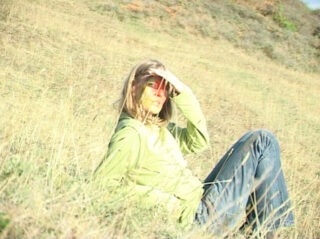ML Buch: “For about three years I went out and recorded the wind”
From Kalundborg with love: how the Danish musician created her new album looking at the ocean while sat in her car

From Kalundborg with love: how the Danish musician created her new album looking at the ocean while sat in her car
In her Copenhagen apartment, Marie Louise Buch’s dog, a three-year-old Labrador, distracts herself with a small plate of peanut butter. A juvenile sun hits the shelf beside her and then falters, briefly illuminating some well-read, slanting books about strange instruments. The quiet equanimity of the morning comes clearly through the computer screen.
ML Buch’s second album, Suntub, was released late last year, but ebbed unobtrusively into end-of-year best lists, unassuming but resolute. Recorded in Kalundborg, a small Danish city on the north-western coast of Zealand, it was deeply inspired by its environment.
“Mostly I was in my own company, or just with nature,” she explains of the medieval town. “I was dealing with feelings like connection and isolation, the need for intensity and euphoria, and shards of light and fire, and connections with something or someone. I was also just nerding out, you know, with weird ways of playing guitars.”
Her voice is gentle and contemplative, waiting to find the right words to describe her process before she speaks them. She smiles when she picks the wrong one, not wanting to sound “too dreamy” when recounting being awestruck by the horizon, or the water lapping either side of the Røsnæs peninsular.
“The thought of sitting in a studio in Copenhagen wasn’t appealing to me. I needed to get out. I needed to – ugh, it sounds – I needed to find my own voice.” She laughs, rolling her eyes. “There’s just a lot of noise and distraction here, which I also love. It’s a huge quality in a place if it can distract you. I just needed some different distractions. Maybe a little calm.”
For Buch, a remedy was to distance formality from the recording process, sitting in her Peugeot SUV, staring out at the ocean and playing early sketches from the stereo, tracking vocals above each instrumental. “It’s my favourite thing to look at,” she concedes. “The glints on the water. And the landscapes in the sky. It’s been inspiring to so many people for so long. It’s just an eternal, like a portal to some other place.

“What I miss most is just the sound of Kalundborg, you know. For about three years I went out and recorded the wind. A lot of the music on Suntub has that. You might not hear it, but it’s in the depth and the detail. What’s important is how the sounds feel,” she stresses. “If I could add dimensions to a sound, that was something that interested me. Taking a sound and playing it back in a car, or through an amp in a big warehouse with a wooden ceiling, and recording it again.”
She took that process with her wherever she went, recording and re-recording in swimming pools, saunas, changing rooms and waterfront storage spaces. The results revel in total disorientation, where strata of sound drift with aimless intent, spot-lit and eclipsed layer by layer. And then, in each fracture comes a sticky-sweet pop song and a luminous invitation to float away on its surface and dive its depths.
“It’s so abstract what I’m going to say, but the material is both coming together and falling apart. I see it as a whole world where the individual pieces are tableaus floating in the air of a much bigger thing. And in these worlds, there are disjointed bodies and different textures and sounds, different types of lights and reflections and membranes and utterings. There aren’t a lot of narratives; it’s more descriptions of locations. I don’t know if that’s what anyone hears, but it’s like the whole album is a container of something. The lyrics are sort of hollow, like other little containers of you as a listener.”
At the same time, Buch stresses the craft of songwriting – the landscapes she creates are propped by melodies, and a lot of assembled material. “I’m curious to find other hierarchies. A guitar fill is sometimes as important as a vocal line,” she emphasises. “I have this human voice and it’s good for communicating something, but I love to communicate, and sometimes it’s best to give weight to other things. Suntub – how do you say it – it’s a composite. I’ve had a feeling of its parts for a long time, and then it became a fun chain of experiments. And now it’s an album,” she beams, happy as a Labrador with a plate of peanut butter. “That’s crazy.”